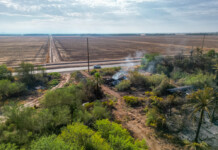
The last few days have seen extreme temperatures throughout Arizona. For motorists traveling in the summer heat a tire blowout or mechanical failure can be a stressful experience to say the least. The Arizona Department of Public Safety (DPS) offers some summer driving and safety tips to help motorists deal with such occurrences.
Aside from keeping plenty of drinking water in your vehicle, along with a first aid kit, there are tips that can help you prevent a tire or mechanical failure or safely respond to such a failure if one occurs.
The first thing a motorist needs to do in order to help prevent a tire or mechanical failure is make sure their vehicle is being properly maintained. The following tips can help motorists stay on track with vehicle maintenance items vital to safe summer driving:
· Follow your vehicle manufacture’s suggested maintenance schedule and guidelines. Check your vehicle’s fluid levels regularly to ensure proper levels are maintained and check belts and hoses for a dry or cracked appearance. Also, check your regular parking area for any oils or fluids that may have accumulated on the ground, before major internal damage is done to your vehicle.
· Properly inflate your vehicle’s tires, including the spare, and check the pressure with an accurate tire gauge when you fuel up or monthly, whichever is first. When adding air to tires, inspect them for tire wear. Tires can lose one to 10 pounds of pressure (psi) a month.
· Rotate and balance wheels and tires once every to 6,000 to 8,000 miles, if no rotation schedule is specified in the owner’s manual for your vehicle. By rotating your tires regularly, it will lengthen the life span of your tires, saving you time and money.
However, even if you follow maintenance guidelines, your vehicle can still experience a tire or mechanical failure. The following tips can help guide your actions should your vehicle experience a failure:
· The first indication of a tire failure could be a loud booming sound (blowout), or the feel of your vehicle pulling to one side of the road along with a bumpy ride. This is an extremely important moment for the driver; it is critical that the he or she stay calm and avoid panicking.
· Do NOT brake at this moment.
· Do NOT take your foot off the accelerator at this moment.
· Instead, ease your foot into the accelerator to maintain your vehicle’s momentum or speed.
· Compensate for pull by counter steering.
· Find a safe location, preferably a freeway exit, decelerate or brake lightly, and park away from traffic. Put your hood up and call for help or make arrangements with your motor club, or a local tow or roadside service if necessary. Or, refer to the vehicle owner’s manual to perform the tire change or repair on your own, as long as you are comfortable doing so.
Additional tips:
· In the event of any vehicle problem, most importantly, maintain control of your vehicle, and then worry about the cause of the problem.
· Buckle-up: make sure you and all your vehicle’s occupants are properly restrained.
· Keep proper seat and hand positions and utilize good driving habits.
· Drive alert, attentive and sober. If you become tired, pull over in a safe place and rest. Avoid unnecessary distractions, such as text messaging, or reaching within the vehicle to pick up a dropped item or to attend to a back seat passenger.
· Obey traffic laws: These laws are in place for a reason. Not only are violations like speeding and aggressive driving illegal, but they also present dangers to you, your passengers and others on the roadway. In addition, such violations are very hard on your vehicle. Speeding, tailgating and aggressive driving greatly increase your chance of being involved in a collision and reduce the amount of time you have to avoid one.
· Move Over, it’s the law: When you see flashing lights ahead, move over and slow down. Passed by the Arizona legislature and signed into law by Governor Janet Napolitano in 2005, the “Move Over” law gets its name from the idea of having drivers safely merge to an adjacent lane on highways with two or more lanes proceeding in the same direction when police or emergency personnel are stopped near or on the road. The law recognizes that sometimes it is not possible, or the second lane just does not exist to move over. Those situations call for reduced speeds and proceeding with extreme caution.
File photo


![Rizz party organizers say city ‘lying’ One of several flyers for a "TikTok rizz party" is taped to a door in the Maricopa Business Center along Honeycutt Road on April 23, 2024. [Monica D. Spencer]](https://www.inmaricopa.com/wp-content/uploads/2024/04/spencer-042324-tiktok-rizz-party-flyer-web-218x150.jpg)
![Province writer opens the athlete’s mind in new book Tom Schuman, a Province resident, poses with a copy of his new book, "My Wide World of Sports," outside his home on May 2, 2024. [Monica D. Spencer]](https://www.inmaricopa.com/wp-content/uploads/2024/05/spencer-050224-tom-schuman-sports-book-web-01-218x150.jpg)







![Maricopa restaurateur makes Food Network connection [Namkeen Dhaba]](https://www.inmaricopa.com/wp-content/uploads/2024/04/439456716_377105198650519_7536248579664805896_n-218x150.jpg)
![Merging lanes incite more 347 anger A merging lane sign sits on the side of State Route 347 northbound lanes during evening traffic on April 30, 2024. [Monica D. Spencer]](https://www.inmaricopa.com/wp-content/uploads/2024/04/spencer-043024-adot-merging-lanes-347-web-218x150.jpg)



